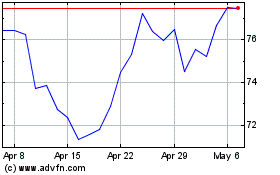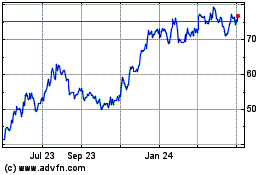East West Bancorp, Inc. (“East West” or the “Company”) (Nasdaq:
EWBC), parent company of East West Bank, has provided the following
unaudited financial update.
“In light of recent industry events and market volatility, we
reiterate that East West Bank’s business model is diversified, our
balance sheet is managed conservatively, and our liquidity is
strong. Our industry-leading profitability and our high-quality
earnings have resulted in very strong capital levels, which form a
firm foundation for our bank,” stated Dominic Ng, Chairman and CEO
of East West.
Diversification and granularity are strengths of East West’s
balance sheet and business model.
- Year-to-date, consumer deposits are up 3% and commercial
deposits have been essentially stable. Total deposits were $55.3
billion as of March 10, 2023, compared with $56.0 billion as of
December 31, 2022, because of a planned and intentional reduction
in brokered deposits of over $1 billion throughout the first
quarter.
- Deposits are well-diversified by industry and depositor type
with no significant customer or sector concentrations. Venture
capital deposits were approximately $1 billion as of March 10,
2023, or less than 2% of total deposits. We have no exposure to
cryptocurrency.
East West’s capital ratios are among the strongest in the
banking industry.
- As of December 31, 2022, East West’s tangible common equity
ratio1 was 8.7%, far exceeding the median of 6.3% for money-center
banks or 6.7%2 for regional and smaller banks.
- As of December 31, 2022, our common equity tier 1 ratio was
12.7%, and our total capital ratio was 14.0%. All our regulatory
capital ratios expanded quarter-over-quarter in the fourth quarter
of 2022, and all our capital ratios substantially exceed regulatory
requirements.
East West’s balance sheet is conservatively managed, and we
have strong liquidity. Our available, unused borrowing capacity
was $28 billion as of March 13, 2023, equivalent to over 50% of
total deposits.
The asset quality of our loan portfolio continues to be
strong and stable. We have experienced no changes in our credit
metrics since year-end, including to classified loans,
non-performing assets, and charge-off ratios. As of December 31,
2022, non-performing assets were 16 basis points of total
assets.
About East West
East West Bancorp, Inc. is a public company with total assets of
$64.1 billion and is traded on the Nasdaq Global Select Market
under the symbol “EWBC”. The Company’s wholly-owned subsidiary,
East West Bank, is the largest independent bank headquartered in
Southern California, operating over 120 locations in the United
States and in Asia. The Company’s markets in the United States
include California, Georgia, Illinois, Massachusetts, Nevada, New
York, Texas and Washington. In China, East West’s presence includes
full-service branches in Hong Kong, Shanghai, Shantou and Shenzhen,
and representative offices in Beijing, Chongqing, Guangzhou,
Xiamen. East West also has a representative office in Singapore.
For more information on East West, visit the Company’s website at
www.eastwestbank.com.
Forward-Looking Statements
Certain matters set forth herein (including any exhibits hereto)
contain forward-looking statements that are intended to be covered
by the safe harbor for such statements provided by the Private
Securities Litigation Reform Act of 1995. In addition, the Company
may make forward-looking statements in other documents that it
files with, or furnishes to, the U.S. Securities and Exchange
Commission (“SEC”) and management may make forward-looking
statements to analysts, investors, media members and others.
Forward-looking statements are those that do not relate to
historical facts and that are based on current expectations,
beliefs, estimates, assumptions and projections, many of which, by
their nature, are inherently uncertain and beyond the Company’s
control. Forward-looking statements may relate to various matters,
including the Company’s financial condition, results of operations,
plans, objectives, future performance, business or industry, and
usually can be identified by the use of forward-looking words, such
as “anticipates,” “assumes,” “believes,” “can,” “continues,”
“could,” “estimates,” “expects,” “forecasts,” “goal,” “intends,”
“likely,” “may,” “might,” “objective,” “plans,” “potential,”
“projects,” “remains,” “should,” “target,” “trend,” “will,”
“would,” or similar expressions or variations thereof, and the
negative thereof, but these terms are not the exclusive means of
identifying such statements. You should not place undue reliance on
forward-looking statements, as they are subject to risks and
uncertainties, including, but not limited to, those described
below. When considering these forward-looking statements, you
should keep in mind these risks and uncertainties, as well as any
cautionary statements the Company may make.
There are various important factors that could cause future
results to differ materially from historical performance and any
forward-looking statements. Factors that might cause such
differences, include, but are not limited to: changes in the global
economy, including an economic slowdown, capital or financial
market disruption, supply chain disruption, level of inflation,
interest rate environment, housing prices, employment levels, rate
of growth and general business conditions, which could result in,
among other things, reduced demand for loans, reduced availability
of funding or increases in funding costs, declines in asset values
and /or recognition of allowance for credit losses on securities
held in the Company’s portfolio; changes in local, regional and
global business, economic and political conditions and geopolitical
events, such as the military conflict between Russia and Ukraine;
the economic, financial, reputational and other impacts of the
ongoing Coronavirus Disease 2019 (“COVID-19”) pandemic, including
variants thereof, and any other pandemic, epidemic or
health-related crisis; changes in laws or the regulatory
environment, including regulatory reform initiatives and policies
of the U.S. Department of the Treasury, the Board of Governors of
the Federal Reserve System (“Federal Reserve”), the Federal Deposit
Insurance Corporation, the Office of the Comptroller of the
Currency, the SEC, the Consumer Financial Protection Bureau and the
California Department of Financial Protection and Innovation -
Division of Financial Institutions; changes and effects thereof in
trade, monetary and fiscal policies and laws, including the ongoing
trade, economic and political disputes between the U.S. and the
People’s Republic of China and the monetary policies of the Federal
Reserve; changes in the commercial and consumer real estate
markets; changes in consumer or commercial spending, savings and
borrowing habits, and patterns and behaviors; the impact from
potential changes to income tax laws and regulations, federal
spending and economic stimulus programs; the impact of any future
federal government shutdown and uncertainty regarding the federal
government’s debt limit; the Company’s ability to compete
effectively against financial institutions and other entities,
including as a result of emerging technologies; the soundness of
other financial institutions; the success and timing of the
Company’s business strategies; the Company’s ability to retain key
officers and employees; impact on the Company’s funding costs, net
interest income and net interest margin from changes in key
variable market interest rates, competition, regulatory
requirements and the Company’s product mix; changes in the
Company’s costs of operation, compliance and expansion; the
Company’s ability to adopt and successfully integrate new
technologies into its business in a strategic manner; the impact of
the benchmark interest rate reform in the U.S., including the
transition away from the U.S. dollar (“USD”) London Interbank
Offered Rate (“LIBOR”) to alternative reference rates; the impact
of communications or technology disruption, failure in, or breach
of, the Company’s operational or security systems or
infrastructure, or those of third party vendors with which the
Company does business, including as a result of cyber-attacks; and
other similar matters which could result in, among other things,
confidential and/or proprietary information being disclosed or
misused, and materially impact the Company’s ability to provide
services to its clients; the adequacy of the Company’s risk
management framework, disclosure controls and procedures and
internal control over financial reporting; future credit quality
and performance, including the Company’s expectations regarding
future credit losses and allowance levels; the impact of adverse
changes to the Company’s credit ratings from major credit rating
agencies; the impact of adverse judgments or settlements in
litigation; the impact on the Company’s operations due to political
developments, pandemics, wars, civil unrest, terrorism or other
hostilities that may disrupt or increase volatility in securities
or otherwise affect business and economic conditions; heightened
regulatory and governmental oversight and scrutiny of the Company’s
business practices, including dealings with consumers; the impact
of reputational risk from negative publicity, fines, penalties and
other negative consequences from regulatory violations, legal
actions and the Company’s interactions with business partners,
counterparties, service providers and other third parties; the
impact of regulatory investigations and enforcement actions;
changes in accounting standards as may be required by the Financial
Accounting Standards Board or other regulatory agencies and their
impact on critical accounting policies and assumptions; the
Company’s capital requirements and its ability to generate capital
internally or raise capital on favorable terms; the impact on the
Company’s liquidity due to changes in the Company’s ability to
receive dividends from its subsidiaries; any strategic acquisitions
or divestitures; changes in the equity and debt securities markets;
fluctuations in the Company’s stock price; fluctuations in foreign
currency exchange rates; the impact of increased focus on social,
environmental and sustainability matters, which may affect the
Company’s operations as well as those of its customers and the
economy more broadly; and the impact of climate change, natural or
man-made disasters or calamities, such as wildfires, droughts and
earthquakes, all of which are particularly common in California, or
other events that may directly or indirectly result in a negative
impact on the Company’s financial performance.
For a more detailed discussion of some of the factors that might
cause such differences, see the Company’s Annual Report on Form
10-K for the year ended December 31, 2021 under the heading Item
1A. Risk Factors and the information set forth under Item 1A. Risk
Factors in the Company’s Quarterly Reports on Form 10-Q. You should
treat forward-looking statements as speaking only as of the date
they are made and then actually known to the Company. The Company
does not undertake, and specifically disclaims any obligation to
update or revise any forward-looking statements to reflect the
occurrence of events or circumstances after the date of such
statements except as required by law.
1 Tangible common equity ratio is a non-GAAP financial measure.
See reconciliation of GAAP to non-GAAP measures in our fourth
quarter 2022 financial press release.
2 Based on median of regional banks and selected west coast
community banks greater than $15 billion in assets. U.S.
subsidiaries of foreign banks, broker-dealers, and specialty
lenders are excluded. Peer data is sourced from S&P Capital
IQ.
View source
version on businesswire.com: https://www.businesswire.com/news/home/20230313005350/en/
FOR INVESTOR INQUIRIES, CONTACT:
Irene Oh Chief Financial Officer T: (626) 768-6360 E:
irene.oh@eastwestbank.com
Julianna Balicka Director of Investor Relations and Corporate
Finance T: (626) 768-6985 E: julianna.balicka@eastwestbank.com
East West Bancorp (NASDAQ:EWBC)
Historical Stock Chart
From Mar 2024 to Apr 2024

East West Bancorp (NASDAQ:EWBC)
Historical Stock Chart
From Apr 2023 to Apr 2024
